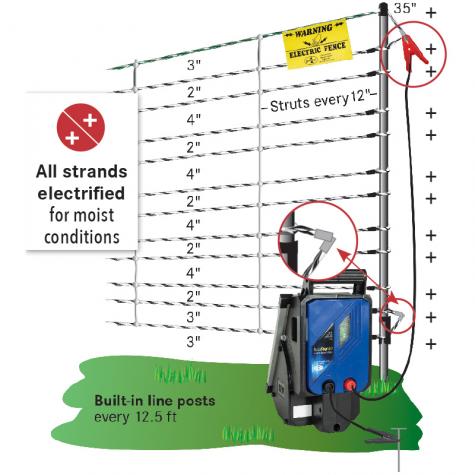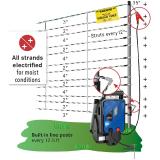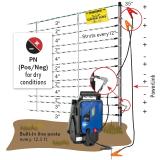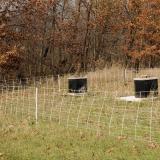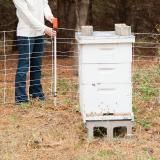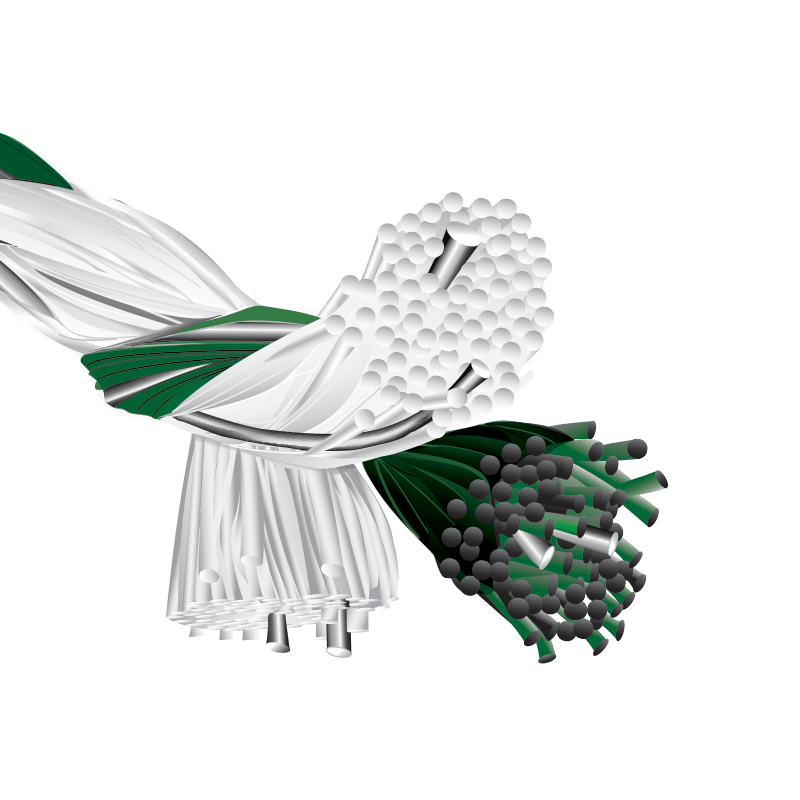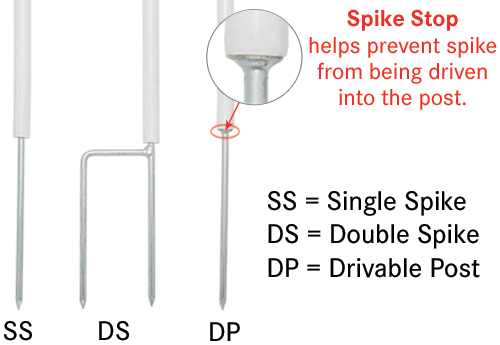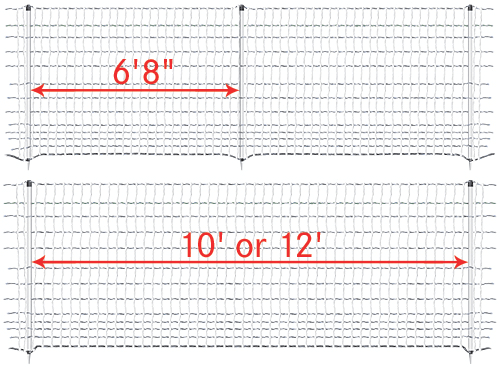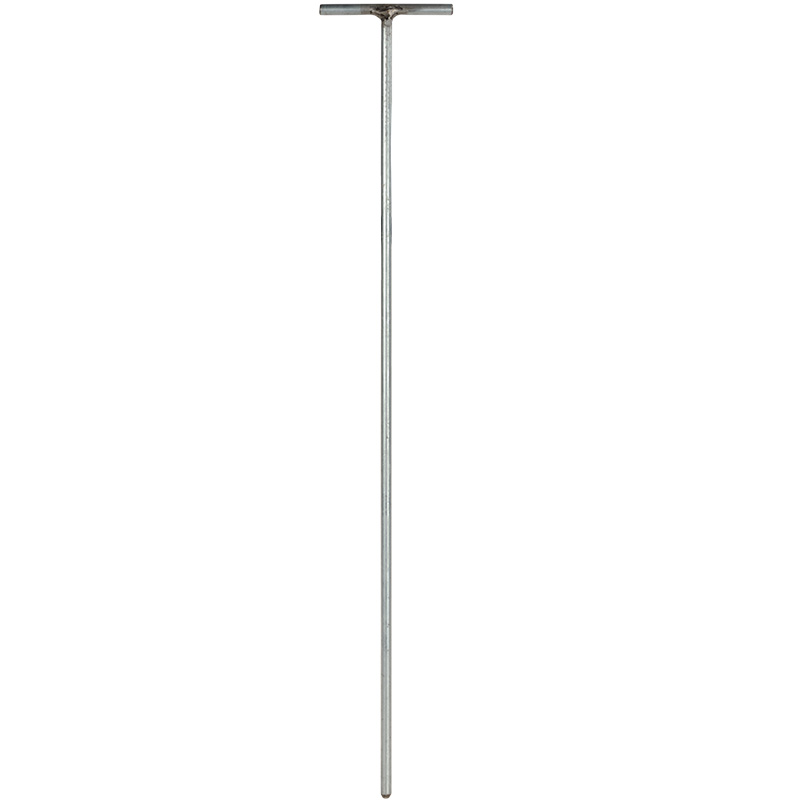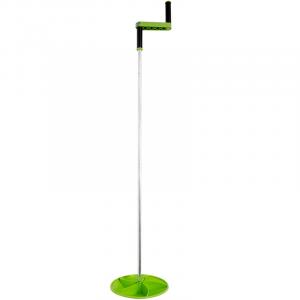Bear QuikFence® 12/35/12
Instructions/Diagrams
It can be set up as a Pos/Neg fence. What does this accomplish?
It eliminates the need for the soil to carry pulse back to the ground rod—providing superior results when soils are dry. The animal will receive a shock when it touches a positive (“+”) strand and a negative (“-”) strand at the same time. How to set up:- At the top of the netting, disconnect the 2 stainless steel clips (diagram at right).
- Using a PowerLink connect the lower clip to the ground rod.
- Connect fence lead to the netting’s top clip.
What are Drivable Posts-DP?
They can be pounded (brown drive-cap to easily determine which posts are drivable) in with a dead-blow hammer or mallet. Single spike (only) has a flange for support when inserting post.| Specifications | |
|---|---|
| Height | 35" installed |
| Horizontal Strands | 12 conductive |
| Vertical Strands | Plastic struts spaced every 12" |
| Roll Length | 50' or 100' |
| Color | White/Black |
| Premium Superconductor | Yes |
| Electrical Resistance | 380 Ω/per 1000' |
| Line Post Options | Single Spike (SS) Drivable Posts (DP) |
| Line Post Material | White PVC, 0.75" diameter |
| Spike Length/Diameter | 8"/0.31" |
| Distance Between Posts | 12.5' |
| Horizontal Spacings | 3", 2", 4", 2", 4", 2", 4", 2", 4", 2", 3" (from bottom to top) |
To Install
The same “unroll and then unfold” process applies to all electrified nets. However, this net is heavier and post spikes are larger than our other nets (therefore more difficult to push into the soil). Extra supports such as FiberTuff™ step-in posts are useful at corners, curves and ends. You will need a fence energizer to electrify the net.Even for new users, it takes less than 10 minutes to go from out-of-the-box netting to installed fence. And it’s durable! Nets last over 10 seasons if used and stored properly. (Its mortal enemy is errant lawn mowers!)
FREE shipping on qualified orders over $100!
How To Purchase
- Measure the fence line.
- Choose the length and the amount of netting needed. (Example: A 250 ft fence requires two 100 ft net and one 50 ft net.)
- Choose from:
- Complete starter kit—includes netting, extra support posts, energizer, ground rod and a wireless tester.
- Netting only.
- Energizer kits (includes charger, ground rod and wireless tester) or energizers only.
- Posts and accessories.
We offer many fences to fit your situation, including different heights and lengths, multiple colors, drivable posts and positive/negative options for dry soils. Questions? Call our fence consultants at
-
$516.00
-
Fencing
Bear QuikFence® 12/35/12 with drivable posts (100' x 35" white/black roll), single spike
Item #205100 -$198.50 -
Fencing
Bear QuikFence® 12/35/12 with drivable posts (50' x 35" white/black roll), single spike
Item #205050 -$157.50 -
$61.00
-
2025 New Products
Premier PRS Pro 100 Energizer, blue
Item #113800 -Suitcase-style solar powered 1.0 joule electric fence energizer. Ideal for rotational graziers. Rugged! Built to withstand heavy on-farm use.
$473.00 -
Energizer Kits
SolarStop™ 80 Fence Energizer Kit
Item #113610 -Solar powered 0.8 output joule energizer for electric fences. Used to contain sheep, goats, poultry, swine, cattle and horses. Effective against predators.
$304.00 -
Energizers
SolarStop™ 240 Fence Energizer
Item #113710 -Portable, 2.4J output solar powered electric fence energizer. Effectively contains domestic livestock while keeping out ground-based predators.
$573.00 -
Energizer Solar Panels and Accessories
8 joule DIY Solar Energizer Kit, 90 watt panel
Item #113104 -Build your own 4- or 8-joule solar-powered electric fence charger. Kit includes all the components to energize livestock fences without access to 110V power.
$816.00 -
Energizer Kits
HotShock 5 (Plug-In) Energizer Kit
Item #1120052 -A versatile 110V AC or 12V DC unit which can be used as a plug-in energizer or as a battery energizer. Adapts from one style to the other in a few seconds.
$173.30 -
Energizer Kits
HotShock 5 (Battery) Energizer Kit
Item #1120053 -A 110V AC or 12V DC electric fence energizer used to contain poultry, cattle, sheep, goats, horses and guard dogs. Effective against predators.
$143.00 -
Energizer Kits
Kube 4000 (Plug-In) Energizer Kit
Item #115111 -An economic 110V wide-impedance electric fence energizer kit used for medium length fences.
$240.30
-
Posts and Accessories
FiberTuff™ Post, 35" tall, 19mm dia
Item #208053 -Fiberglass-reinforced support posts for ends, corners and major directional changes. Commonly used with electrified net fences.
$4.50 -
Posts and Accessories
NetPost 19/35/DP, white
Item #205010 -19mm (0.60") diameter replacement PVC posts for Premier’s electric netting. Available in multiple heights, colors, and post spike options.
$3.80
-
Fence Connectors and Accessories
PowerLink™ 4.0, 30" long
Item #335500 -Make instant, in-field connections between electric fences without turning off the energizer. Simple to use and effective.
$5.50 -
Fence Connectors and Accessories
Fence & Battery Digital Tester
Item #200010 -All-in-one fence tester checks the voltage of energizers, fences and 12V batteries. Simplify electric fence troubleshooting with one device!
$38.00 -
Fencing
Warning Sign
Item #346000 -Let passersby know that your fences are electrified with this easy-to-read electric fence warning sign.
$2.50 -
Fence Connectors and Accessories
Dead Blow Hammer, orange
Item #205015 -Versatile hammer delivers a controlled impact with minimal vibration and rebound.
$11.00 -
Handling Equipment
Ground Rod and/or Connecting Pin, 3'
Item #151200 -Effectively ground energizers or firmly secure handling equipment. Galvanized pin is resilient to rust and wear.
$11.00 -
Fence Connectors and Accessories
T Ground Rod, 3' x 1/2"
Item #151210 -Provide a conductive ground circuit for your electric fence. Conductive t-grip is easy to install and remove.
$20.00 -
Fence Connectors and Accessories
Stainless Steel Clamp
Item #151800 -Stainless steel hose clamp. Firmly holds negative leads from the energizer to the ground rod.
$1.30 -
Energizer Solar Panels and Accessories
MaxiShock Double Insulated Cable, 100'
Item #164207 -Pliable double insulated cable for above-ground electric connections. Excellent conductivity (19 Ω/1,000 ft) make it a good choice for high voltage electric fence systems.
$38.00 -
Wind-up Systems and Accessories
Twist Butler, for 42" nets (and less)
Item #100101 -Convenient reel system for rolling up and unwinding electric nets. Helps to install netting quickly and easily. Fits most nets up to 164' in length.
$66.00 -
Fence Connectors and Accessories
Repair Kit for Bear QuikFence, ElectroFence & Plus, ElectroNet (DP), ElectroStop (DP), PermaNet, Plus & Pro, PoultryNet (DP) & VersaNet 60
Item #201730 -A handy repair kit that includes all of the essentials to patch tears and holes in electric net fences.
$2.00 -
Fence Connectors and Accessories
Litzclip® Vertical Strut Repair Set, (2) 2-way, (2) 3-way & (2) 4-way (pkg of 6)
Item #200015 -Quickly repair broken electric fences with Litzclip® for vertical struts. Plastic and stainless steel connectors hold net securely. No tools required.
$10.50 -
Fence Connectors and Accessories
Litzclip® Repair Set, 3mm (4) 2-way, (2) 3-way & (2) 4-way
Item #200008 -Repair electric net fences simply, quickly and securely. No tools required! For electric netting and other 3mm conductors.
$9.75
Precautions
Electric fence is a pain barrier, not a physical barrier. A common mistake is not electrifying it. Animals may escape or become entangled (and may die). On a % basis, entanglement is very rare, but it can and does occur. If animals are scared or starved it will not keep them in. The first time you put the animals in the net, you should be available to watch them for a while. That way if one were to get into the fence and get caught, you can turn the power off and get them loose.
Warning! Due to risk of fire, do NOT use continuous output energizers with electric netting or electro-plastic conductors such as rope, twine or tape. Use only with a low or wide impedance intermittent pulse energizer. (Fi-Shock™ brand energizers which are sold as low impedance, continuous current output should NOT be used with electric netting.) All energizers sold on Premier’s website use an intermittent pulse and are suitable for use with electric netting.
Dry conditions and wintertime usage may reduce the effectiveness of electric fencing. Ice and heavy snow can flatten netting and thereby damage it.
Dry or frozen ground may cause post spikes to bend or break if inserted with force. Pilot holes may be needed. We recommend using drivable or single spike posts in hard soils. Double spike posts provide more stability when the ground is soft.


